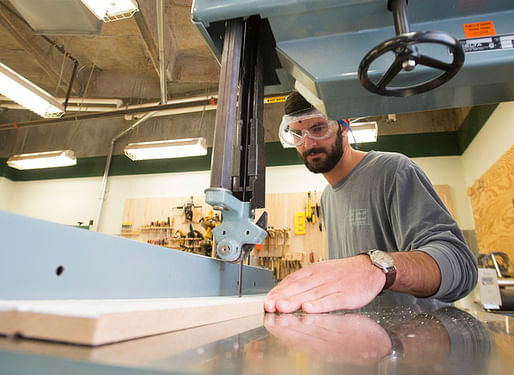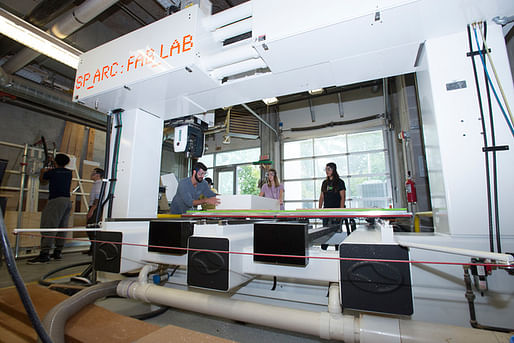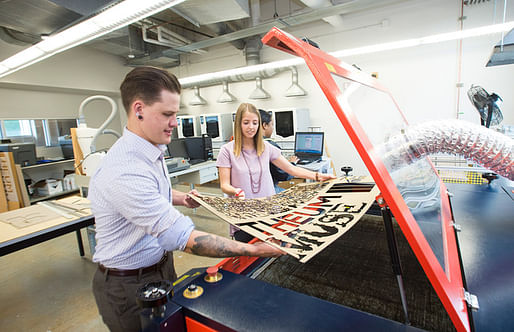

Architecture’s relationship to technology is as old as the primitive hut. Material and construction technologies have shaped design and detailing throughout history. But with the dawn of the information age came a new category of technologies that have shaped architecture in fresh new ways. Initially, these digital programs were treated as an extension of Representation theory. For architects, the debut of AutoCAD and form·Z would prove transformative similarly to the way the plan and section impacted architectural theory and practice during the Renaissance. Prospects of virtual reality in the 1990s had architectural theorists musing on the possible obsolescence of brick and mortar buildings.
By the late 1990s, computer-aided design products like AutoCAD had become a standard tool in architectural offices. In response, the academy speculated on the elimination of the traditional art studio concept with its drafting tables, opting instead for a computer lab concept driven by the belief that new software products meant models, drafting and sketches might no longer be needed. That idea did not last long. After all, media are only representation through a given filter. Limit the filter and it limits the cognitive capabilities of intellectual exploration and investigation of the design process. Students still needed to sketch and make models to explore ideas.
Powerful Technologies
With each passing year, the architecture industry adds more software products to the list: Maya, Rhino, Grasshopper, Revit, to name a few. Architects no longer see these technologies as replacements, but additions.
These powerful technologies do crowd academic curriculums and test faculty and student endurance, but they enrich and expand on the basic skill sets of the profession, no longer limiting investigations. Many architectural firms now include software testing as part of their interview process similar to how they would have requested examples of drafting in days past.
In the last 10 years, technological advances in fabrication tools have also proven transformative at an ever-increasing pace. Laser cutters, 3D printers, CNC routers and robotic arms are commonplace in academia. These high-tech tools allow Kennesaw State University, and many architectural programs around the country, to reintroduce the investigation of fabrication into the curriculum, make the educational process more dynamic and enhance critical thinking. These attractive tools provide opportunity for pragmatic research while attracting grant dollars, making them well worth the initial capital investment and ongoing maintenance costs.
What is the impact of this revolution on the nature, space and infrastructure of the architecture studio? And perhaps more importantly, how can we effectively develop that infrastructure to better serve students and control some of the added costs to architectural education?
Innovative Infrastructure

The most obvious infrastructural changes stem from the introduction of new tools. Historically, most programs had wood shops or photography darkrooms. Then, computer labs were added.
Today it is hard to imagine an architectural program without a digital fabrication lab. Their extent ranges from dedicated facilities like KSU’s Digi_lab that houses a vacuform machine, a professional etching machine, five 3D printers, five laser cutters, one large format laser cutter, a three-axis CNC router and a five-axis CNC router, to more advanced research facilities like Ball State’s Institute for Digital Fabrication, Georgia Tech’s Digital Building Laboratory or the University of Michigan’s FabLab. More advanced prototyping equipment allows for product innovation and testing, as well as exploration of rapid prototyping and on-site construction automation.

An important addition to architectural education, this infrastructure refocuses attention on fabrication and craft, allowing for investigation of the tectonic details of building that are both aesthetic and performative in formulation. Having access to these tools and labs encourages a form of entrepreneurial architecture where the individual controls the entire process of production from concept to prototype to the application of their designs. These facilities often result in the production of high-impact work that is both educational and highly marketable.
Improving Educational Space
To enhance the day-to-day working experience for students, Kennesaw State integrates supporting infrastructure directly into the studio. Production labs are indispensable but have often distracted from the need for innovative studio space.
How Kennesaw State students interact with digital media in studio is mainly through desktop or laptop computer in a student’s designated workstation. This works well during a desk crit, when the faculty member comes to the desk to review a drawing, model or digital version, and maintains the traditional spatial format of the studio. But other times, having individual computers within the studio space is less effective, especially in review formats such as collaborative exercises, informal studio crits and formal juries where digital work including fly-throughs, animations and movies are presented to larger groups. The limited size of the laptop screen may hinder a presentation and the education experience.

Architecture faculty at Kennesaw State became acutely aware of this fundamental problem and the need to reconceptualize the space of the studio. This happened rather organically as faculty repeatedly took their students from studio into a classroom to present research and collaborative work using overhead projectors. Moving from the studio into the classroom and back again wasted valuable time as students often brought models and drawings with them.
To address the issue, Kennesaw State first introduced 64-inch monitors on rolling carts into the studio. These proved highly effective and removed the necessity of using classrooms. This summer, studio reconfiguration made room for six collaborative labs, named the Co_Labs , which are open cubes that sit within the studio itself. The cubes contain 75-inch flat screen monitors that can be accessed using an Ethernet port or wirelessly by anyone in the studio. Within the Co_Labs, students share information with each other simultaneously on a single screen, collaborate on project modules or give presentations to each other or jurors. The Co_Labs transform the spatial morphology to accommodate the existing digital technology. Integrating classroom space into the studio with these high-tech digital capabilities expands collaboration and increases the efficiency of space for the entire department.
New Tech Expenses
The introduction of new technologies has not come cheaply. Digital fabrication tools are expensive, requiring maintenance and dedicated space. But these tools have become part of the operating expense of every university’s architecture department. The added cost to students, which amounts to nothing less than a premium for a degree in architecture, is often overlooked.
In a previous Archinect article, “The State of Debt and the Price of Architecture,” author Nicolas Korody cited research done by the AIAS that estimated the average architecture student graduates with $40,000 worth of debt compared to the national average of $29,400. The estimated average annual cost of materials and supplies for architecture students is $1,117. For a five-year B.ARCH degree, that is a premium of $5,585.
Most academic programs also require the purchase of a laptop, which range from $2,100 to $3,100, depending on brand, as well as the cost of external portable hard drives. While all college students purchase computers, architecture students must purchase high-performance computers because of the work they must complete while earning a bachelor’s degree.
The price of computer hardware and software licenses continues to rise and is not typically factored into student costs. As the field moves to a more digital platform, university programs must attempt to teach the vital skills that students need to keep pace with the industry.
Software subscriptions
Besides hardware requirements, architecture students also must invest in software products, yet these costs are less transparent. Many university programs require first-year students to have Adobe Creative Suite and Rhino, but many universities provide the software to keep students’ costs low. For example, Adobe Creative Suite student version has an annual subscription of $360.

Few universities list all of the likely software architecture students will use throughout their education, because it’s a long list: Sketchup, T-Splines, Maya, Revit, Grasshopper, Honeybee, Maxwell Render, 3DSMAX, Lady Bug, Radiance, DIVA, Honeybee, Costlink, Green Building Studio, and so on. If the software is not provided by the university, the additional software costs for a five-year B.ARCH student would be $1,680. Most architecture programs purchase licenses and make the software accessible to students. Thankfully, many of the software products are provided to the educational community for free or at a discounted cost. At KSU, 24 software products are available to architecture students within the computer labs. Because of enhanced infrastructure, several of these software programs are already available through in-house networks, allowing student to access them in studio or in the classroom.
Kennesaw State is currently working on developing a cloud-based model similar to that introduced by Autodesk for the profession. In this format, essential software is located on university mainframe servers. The department identifies which software products will be available, and an access portal is set up for all registered students in the program.
A cloud-based model could bring the software to where it is needed most. Students may access the portal on or off campus to work in the studio, library, any classroom or at home, and classes that focus on introducing software could be taught in any location.
Carried on the Cloud
With a cloud-based platform, students’ work is completed and stored on university servers, giving students access to the software to do work on lighter devices, such as an iPad, with less memory and a reduced price tag. Essentially, the cloud-based format eliminates the potential for a computer crash, which previously amounted to lost work and major repair expenses.

Cloud-based platforms also make in-house rendering farms feasible. Generating renderings requires substantial computer memory and locks a student’s computer for 20 hours or more when having to complete a rendering. A cloud-based model would also eliminate the need for students to seek costly outside rendering farms that can return images within minutes. With the university’s support, an in-house rendering farm eliminates another hidden cost for architecture students. Several universities throughout the U.S. have already implemented rending farms within their infrastructure.
A cloud-based system also can provide a ready database of student work, and selected projects can be copied to archives, which provide evidence for self-assessment reports, NAAB reviews and exhibitions of student work. Kennesaw State is still developing this aspect, determining the best quantity of storage available for each student.
The Digital Future
The digital demands of the architecture field continue to grow each year, as university programs like Kennesaw State face those challenges and create innovative infrastructures and high-end computing options. These on-campus changes reflect the desire of today’s architecture programs to stay current with the profession’s technology expectations and help curtail some of the extraneous costs for students while preparing them for architectural careers after graduation.
- by Anthony Rizzuto, Chair, Department of Architecture, Kennesaw State University
Click here to learn more.
No Comments
Block this user
Are you sure you want to block this user and hide all related comments throughout the site?
Archinect
This is your first comment on Archinect. Your comment will be visible once approved.